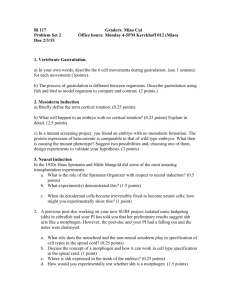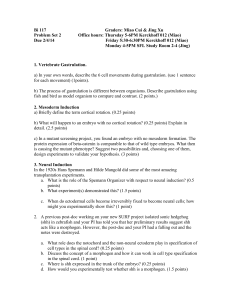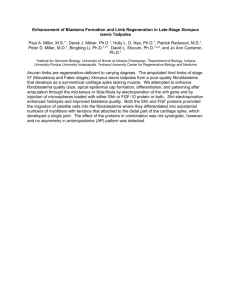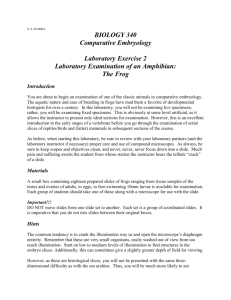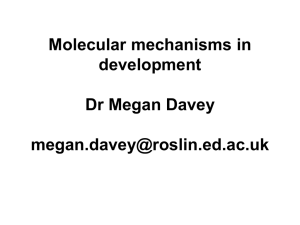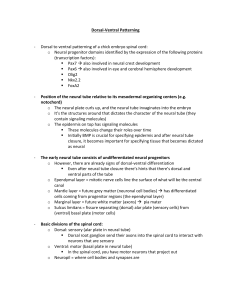Problem Set #2 Due Feb 2, 2012 Grader: Na Office Hours: BI 11
advertisement
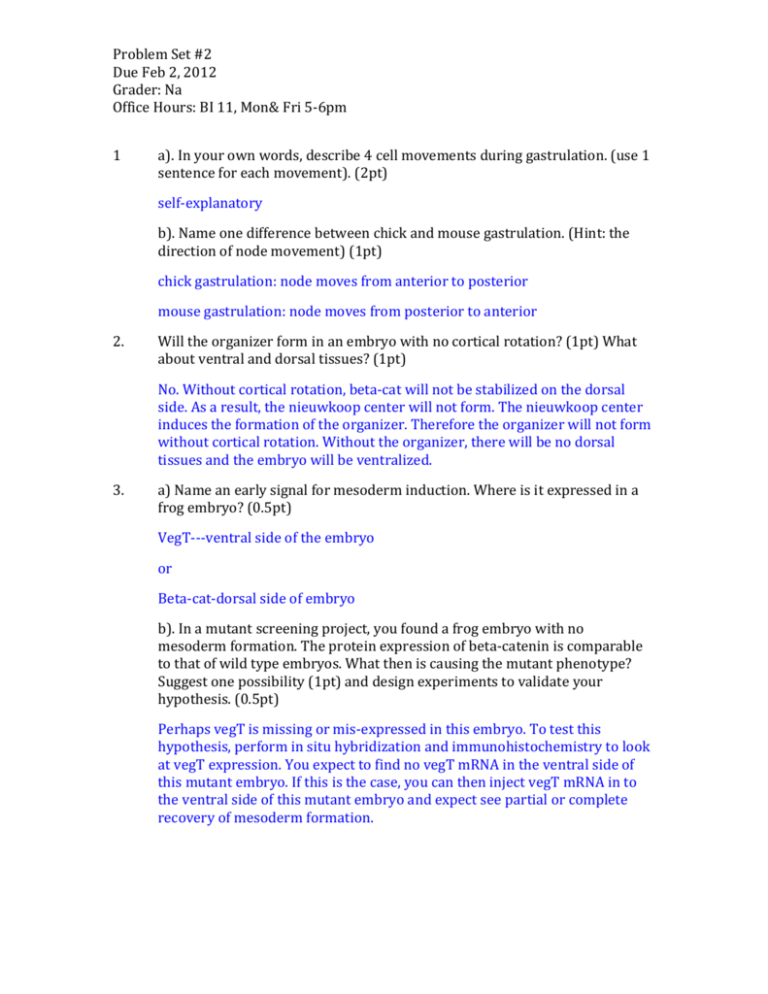
Problem Set #2 Due Feb 2, 2012 Grader: Na Office Hours: BI 11, Mon& Fri 5-6pm 1 a). In your own words, describe 4 cell movements during gastrulation. (use 1 sentence for each movement). (2pt) self-explanatory b). Name one difference between chick and mouse gastrulation. (Hint: the direction of node movement) (1pt) chick gastrulation: node moves from anterior to posterior mouse gastrulation: node moves from posterior to anterior 2. Will the organizer form in an embryo with no cortical rotation? (1pt) What about ventral and dorsal tissues? (1pt) No. Without cortical rotation, beta-cat will not be stabilized on the dorsal side. As a result, the nieuwkoop center will not form. The nieuwkoop center induces the formation of the organizer. Therefore the organizer will not form without cortical rotation. Without the organizer, there will be no dorsal tissues and the embryo will be ventralized. 3. a) Name an early signal for mesoderm induction. Where is it expressed in a frog embryo? (0.5pt) VegT---ventral side of the embryo or Beta-cat-dorsal side of embryo b). In a mutant screening project, you found a frog embryo with no mesoderm formation. The protein expression of beta-catenin is comparable to that of wild type embryos. What then is causing the mutant phenotype? Suggest one possibility (1pt) and design experiments to validate your hypothesis. (0.5pt) Perhaps vegT is missing or mis-expressed in this embryo. To test this hypothesis, perform in situ hybridization and immunohistochemistry to look at vegT expression. You expect to find no vegT mRNA in the ventral side of this mutant embryo. If this is the case, you can then inject vegT mRNA in to the ventral side of this mutant embryo and expect see partial or complete recovery of mesoderm formation. Problem Set #2 Due Feb 2, 2012 Grader: Na Office Hours: BI 11, Mon& Fri 5-6pm 4. A previous post-doc working on your new SURF project isolated sonic hedgehog (shh) in zebrafish and your PI has told you that her preliminary results suggest shh acts like a morphogen. However, the post-doc and your PI had a falling out and the notes were destroyed. a. What role does the notochord and the non-neural ectoderm play in specification of cell types in the spinal cord? (0.25 points) The notochord and the non-neural ectoderm set up the dorsal-ventral (DV) specification in the neural tube. [The roof of the neural tube is exposed to signaling molecules like BMP4 and BMP7 secreted from the epidermis (non-neural ectoderm), and the floor of the neural tube is exposed to Shh secreted from the notochord.] b. Discuss the concept of a morphogen and how it can work in cell type specification in the spinal cord. (1 point) Morphogens are proteins made in specific sites in the embryo, diffuse over long distance, and form concentration gradient where the highest concentration is at the point of synthesis and gets lowers as the morphogen diffuses away from its source and degrades over time. e. g. In the neural tube, shh is secreted from the notochord, ventral to the neural tube, and hence its concentration is the highest in the ventral side. As it diffuses upwards, the concentration gets diluted along the DV axis (high in ventral, low in dorsal). On the other end, BMP4 and BMP7 are secreted from the non-neural ectoderm overlying the neural tube. These proteins diffuse downward along the DV axis (high in dorsal, low in ventral). Different types of neurons of the neural tube are formed by their exposure to these gradients of paracine factors. (e.g. high shh induces formation of motor neuron in the ventral, while high BMPs induces formation of sensory neurons in the dorsal) (Chapter 12, p384.) c. Where is shh expressed in the trunk of the embryo? (0.25 points) Shh is expressed in the notochord and the floor plate, with the highest concentration in the ventral side of the neural tube. d. How would you experimentally test whether shh is a morphogen. (1.5 points) Design an experiment to show that the concentration of shh is important for formation of different types of neurons in the neural tube. e.g. take the undifferentiated neural tube cells, treat it with different concentrations of shh. Should varied concentrations of shh caused formation of different neuronal types, it suggests that shh functions in a gradient manner and is a morphogen
